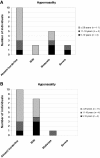Associations between speech features and phenotypic severity in Treacher Collins syndrome
- PMID: 24775909
- PMCID: PMC4101868
- DOI: 10.1186/1471-2350-15-47
Associations between speech features and phenotypic severity in Treacher Collins syndrome
Abstract
Background: Treacher Collins syndrome (TCS, OMIM 154500) is a rare congenital disorder of craniofacial development. Characteristic hypoplastic malformations of the ears, zygomatic arch, mandible and pharynx have been described in detail. However, reports on the impact of these malformations on speech are few. Exploring speech features and investigating if speech function is related to phenotypic severity are essential for optimizing follow-up and treatment.
Methods: Articulation, nasal resonance, voice and intelligibility were examined in 19 individuals (5-74 years, median 34 years) divided into three groups comprising children 5-10 years (n = 4), adolescents 11-18 years (n = 4) and adults 29 years and older (n = 11). A speech composite score (0-6) was calculated to reflect the variability of speech deviations. TCS severity scores of phenotypic expression and total scores of Nordic Orofacial Test-Screening (NOT-S) measuring orofacial dysfunction were used in analyses of correlation with speech characteristics (speech composite scores).
Results: Children and adolescents presented with significantly higher speech composite scores (median 4, range 1-6) than adults (median 1, range 0-5). Nearly all children and adolescents (6/8) displayed speech deviations of articulation, nasal resonance and voice, while only three adults were identified with multiple speech aberrations. The variability of speech dysfunction in TCS was exhibited by individual combinations of speech deviations in 13/19 participants. The speech composite scores correlated with TCS severity scores and NOT-S total scores. Speech composite scores higher than 4 were associated with cleft palate. The percent of intelligible words in connected speech was significantly lower in children and adolescents (median 77%, range 31-99) than in adults (98%, range 93-100). Intelligibility of speech among the children was markedly inconsistent and clearly affecting the understandability.
Conclusions: Multiple speech deviations were identified in children, adolescents and a subgroup of adults with TCS. Only children displayed markedly reduced intelligibility. Speech was significantly correlated with phenotypic severity of TCS and orofacial dysfunction. Follow-up and treatment of speech should still be focused on young patients, but some adults with TCS seem to require continuing speech and language pathology services.
Figures
Similar articles
-
Orofacial functions and oral health associated with Treacher Collins syndrome.Acta Odontol Scand. 2013 May-Jul;71(3-4):616-25. doi: 10.3109/00016357.2012.700065. Epub 2012 Jul 12. Acta Odontol Scand. 2013. PMID: 22783882
-
Orofacial features of Treacher Collins syndrome.Med Oral Patol Oral Cir Bucal. 2009 Jul 1;14(7):E344-8. Med Oral Patol Oral Cir Bucal. 2009. PMID: 19300363
-
Long-Term Surgical and Speech Outcomes Following Palatoplasty in Patients With Treacher-Collins Syndrome.J Craniofac Surg. 2016 Sep;27(6):1408-11. doi: 10.1097/SCS.0000000000002821. J Craniofac Surg. 2016. PMID: 27607112
-
Assessment of craniofacial and dental characteristics in individuals with treacher collins syndrome. A review.J Stomatol Oral Maxillofac Surg. 2021 Nov;122(5):511-515. doi: 10.1016/j.jormas.2020.10.011. Epub 2020 Nov 7. J Stomatol Oral Maxillofac Surg. 2021. PMID: 33166690 Review.
-
Multidisciplinary treatment approach in Treacher Collins syndrome.J Dent Child (Chic). 2012 Jan-Apr;79(1):15-21. J Dent Child (Chic). 2012. PMID: 22449504 Review.
Cited by
-
Assessment of orofacial dysfunction using the NOT-S method in a group of Turkish children with cerebral palsy.Eur Arch Paediatr Dent. 2020 Apr;21(2):215-221. doi: 10.1007/s40368-019-00475-z. Epub 2019 Sep 6. Eur Arch Paediatr Dent. 2020. PMID: 31493279
-
Nordic Orofacial Test-Screening Protocol as a Tool for Assessment of Orofacial Dysfunction in Pediatric and Adult Patients.Diagnostics (Basel). 2025 Jun 29;15(13):1656. doi: 10.3390/diagnostics15131656. Diagnostics (Basel). 2025. PMID: 40647655 Free PMC article.
-
Living with orofacial conditions: psychological distress and quality of life in adults affected with Treacher Collins syndrome, cherubism, or oligodontia/ectodermal dysplasia-a comparative study.Qual Life Res. 2015 Apr;24(4):927-35. doi: 10.1007/s11136-014-0826-1. Epub 2014 Oct 25. Qual Life Res. 2015. PMID: 25344415 Free PMC article.
-
Systematic Review of Current Audiological Treatment Options for Patients with Treacher Collins Syndrome (TCS) and Surgical and Audiological Experiences of an Otorhinolaryngologist with TCS.J Pers Med. 2024 Jan 10;14(1):81. doi: 10.3390/jpm14010081. J Pers Med. 2024. PMID: 38248782 Free PMC article. Review.
References
-
- Dauwerse JG, Dixon J, Seland S, Ruivenkamp CA, van Haeringen A, Hoefsloot LH, Peters DJ, Boers AC, Daumer-Haas C, Maiwald R, Zweier C, Kerr B, Cobo AM, Toral JF, Hoogeboom AJ, Lohmann DR, Hehr U, Dixon MJ, Breuning MH, Wieczorek D. Mutations in genes encoding subunits of RNA polymerases I and III cause Treacher Collins syndrome. Nat Genet. 2011;15:20–22. doi: 10.1038/ng.724. - DOI - PubMed
MeSH terms
LinkOut - more resources
Full Text Sources
Other Literature Sources



